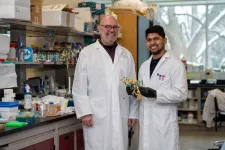(Press-News.org) The last time a new class of antibiotics reached the market was nearly three decades ago — but that could soon change, thanks to a discovery by researchers at McMaster University.
A team led by renowned researcher Gerry Wright has identified a strong candidate to challenge even some of the most drug-resistant bacteria on the planet: a new molecule called lariocidin. The findings were published in the journal Nature on March 26, 2025.
The discovery of the all-new class of antibiotics responds to a critical need for new antimicrobial medicines, as bacteria and other microorganisms evolve new ways to withstand existing drugs. This phenomenon is called antimicrobial resistance — or AMR — and it’s one of the top global public health threats, according to the World Health Organization.
“Our old drugs are becoming less and less effective as bacteria become more and more resistant to them,” explains Gerry Wright, a professor in McMaster’s Department of Biochemistry and Biomedical Sciences and a researcher at the university’s Michael G. DeGroote Institute for Infectious Disease Research. “About 4.5 million people die every year due to antibiotic-resistant infections, and it’s only getting worse.”
Wright and his team found that the new molecule, a lasso peptide, holds great promise as an early drug lead because it attacks bacteria in a way that’s different from other antibiotics. Lariocidin binds directly to a bacterium’s protein synthesis machinery in a completely new way, inhibiting its ability to grow and survive.
“This is a new molecule with a new mode of action,” Wright says. “It’s a big leap forward for us.”
Lariocidin is produced by a type of bacteria called Paenibacillus, which the researchers retrieved from a soil sample collected from a Hamilton backyard.
The research team allowed the soil bacteria to grow in the lab for approximately one year — a method that helped reveal even the slow-growing species that could have otherwise been missed. One of these bacteria, Paenibacillus, was producing a new substance that had strong activity against other bacteria, including those typically resistant to antibiotics.
“When we figured out how this new molecule kills other bacteria, it was a breakthrough moment,” says Manoj Jangra, a postdoctoral fellow in Wright’s lab.
In addition to its unique mode of action and its activity against otherwise drug-resistant bacteria, the researchers are optimistic about lariocidin because it ticks a lot of the right
boxes: it’s not toxic to human cells, it’s not susceptible to existing mechanisms of antibiotic resistance, and it also works well in an animal model of infection.
Wright and his team are now laser-focused on finding ways to modify the molecule and produce it in quantities large enough to allow for clinical development. Wright says because this new molecule is produced by bacteria — and “bacteria aren’t interested in making new drugs for us” — much time and resources are needed before lariocidin is ready for market.
“The initial discovery — the big a-ha! moment — was astounding for us, but now the real hard work begins,” Wright says. “We’re now working on ripping this molecule apart and putting it back together again to make it a better drug candidate.”
Interested in covering this drug discovery?
Gerry Wright, professor of biochemistry and biomedical sciences at McMaster, can be reached directly at wrightge@mcmaster.ca
Manoj Jangra, a postdoctoral fellow in Wright’s lab, can be reached at jangrm1@mcmaster.ca.
For an embargoed copy of the study, please contact Nature directly at press@nature.com.
For any other information, contact Adam Ward, media relations officer with McMaster University’s Faculty of Health Sciences at warda17@mcmaster.ca.
END
A breakthrough moment: McMaster researchers discover new class of antibiotics
2025-03-26
ELSE PRESS RELEASES FROM THIS DATE:
The devastating human impact on biodiversity
2025-03-26
Humans are having a highly detrimental impact on biodiversity worldwide. Not only is the number of species declining, but the composition of species communities is also changing. These are the findings of a study by Eawag and the University of Zurich published in the scientific journal Nature. It is one of the largest studies ever conducted on this topic.
Biological diversity is under threat. More and more plant and animal species are disappearing worldwide, and humans are responsible. Until now, however, there has been no synthesis of the extent of human intervention in nature and whether the effects can be found everywhere in the world ...
Calorie-free sweeteners can disrupt the brain’s appetite signals
2025-03-26
Compared to sugar, consuming sucralose—a widely used sugar substitute—increases activity in the hypothalamus, a brain region that regulates appetite and body weight, according to a new USC study. Sucralose also changes how the hypothalamus communicates with other brain regions, including those involved in motivation. The study was just published in the journal Nature Metabolism.
About 40% of Americans regularly consume sugar substitutes, usually as a way to reduce calories or sugar intake. “But are these substances actually helpful for regulating ...
Researchers achieve quantum computing milestone, realizing certified randomness
2025-03-26
In a new paper in Nature, a team of researchers from JPMorganChase, Quantinuum, Argonne National Laboratory, Oak Ridge National Laboratory and The University of Texas at Austin describe a milestone in the field of quantum computing, with potential applications in cryptography, fairness and privacy.
Using a 56-qubit quantum computer, they have for the first time experimentally demonstrated certified randomness, a way of generating random numbers from a quantum computer and then using a classical supercomputer to prove they are truly random and freshly generated. This could pave the way towards the use of quantum computers for a practical task unattainable through ...
Lasso-shaped antibiotic co-developed by UIC evades standard drug resistance
2025-03-26
A small molecule shaped like a lasso may be a powerful tool in the fight against infectious diseases, according to a new study in Nature co-authored by University of Illinois Chicago researchers.
Lariocidin, a peptide made by bacteria living in soil, was effective against several different microbes responsible for deadly infections. UIC researchers working with collaborators at McMaster University in Canada determined how the new antibiotic works and why the drug evades bacterial resistance.
“The holy grail in the field is to find an antibiotic that binds to a new site target, has a novel mechanism of action and has ...
Two studies explore impact of pandemic on colorectal cancer screening and diagnosis
2025-03-26
INDIANAPOLIS – Two recent studies by researchers from Regenstrief Institute and the Indiana University School of Medicine explore the effect of the pandemic on colorectal cancer screening tests and diagnostic colonoscopies in Central Indiana. The findings of temporary disruption to the former and minimal impact on the latter are similar to findings across the U.S., contributing to the compendium of knowledge on preventive health uptake and subsequent treatment in various populations during the pandemic.
One study, published in PLoS One, examines both non-invasive and colonoscopy screening trends during the pandemic. The other study, ...
“Osteo-cardiovascular” patients at highest risk for falls and death, Chinese study finds
2025-03-26
A new study by researchers at Peking University and the Chinese PLA General Hospital has found that multimorbidity—living with multiple chronic diseases—is closely associated with worsening fall conditions and mortality among middle-aged and older adults in China. The findings, published in Health Data Science, identify a distinct group at especially high risk: individuals with both cardiovascular and musculoskeletal conditions, dubbed the “osteo-cardiovascular fallers.”
Falls are a major cause of injury and death in older populations globally, particularly ...
AI analysis of healthcare records reveals key factors in autism diagnosis
2025-03-26
Without clear and effective biological tests for autism based on genes, brain or blood measurements, diagnosis today still largely depends on clinical assessment. The standard way of doing this is by observing how the individual fits the criteria for autism listed in gold standard manuals like the Diagnostic and Statistical Manual of Mental Disorders, Fifth Edition (DSM-5).
These criteria are divided into two categories: one for restricted or repetitive behaviours, actions, or activities, and another for differences in social communication and interaction. In the end, however, it is the clinician, relying on years of ...
Repetitive behaviors and special interests are more indicative of an autism diagnosis than a lack of social skills
2025-03-26
People with autism are typically diagnosed by clinical observation and assessment. To deconstruct the clinical decision process, which is often subjective and difficult to describe, researchers used a large language model (LLM) to synthesize the behaviors and observations that are most indicative of an autism diagnosis. Their results, publishing in the Cell Press journal Cell, show that repetitive behaviors, special interests, and perception-based behaviors are most associated with an autism diagnosis. These findings have potential to improve diagnostic guidelines ...
Long-term risk of stroke after transient ischemic attack or minor stroke.
2025-03-26
About The Study: Patients who have had a transient ischemic attack (TIA) or minor stroke are at a persistently high risk of subsequent stroke. The findings from this study underscore the need for improving long-term stroke prevention measures in this patient group.
Corresponding Author: To contact the corresponding author, Faizan Khan, PhD, email faizan.khan1@ucalgary.ca.
To access the embargoed study: Visit our For The Media website at this link https://media.jamanetwork.com/
(doi:10.1001/jama.2025.2033)
Editor’s Note: Please see the article for additional information, including other authors, author contributions ...
Using LLMS to understand how autism gets diagnosed
2025-03-26
In diagnosing autism – the developmental variant that affects around 80 million people worldwide – medical practitioners today put too much emphasis on a child's lack of sociability and not enough on their interests and how they naturally behave spontaneously with objects.
And so, to be more accurate in their assessments, health authorities should start tapping the vast analytic powers of artificial intelligence, combined with the experience of clinicians, and come up with better diagnostic criteria.
That's ...




